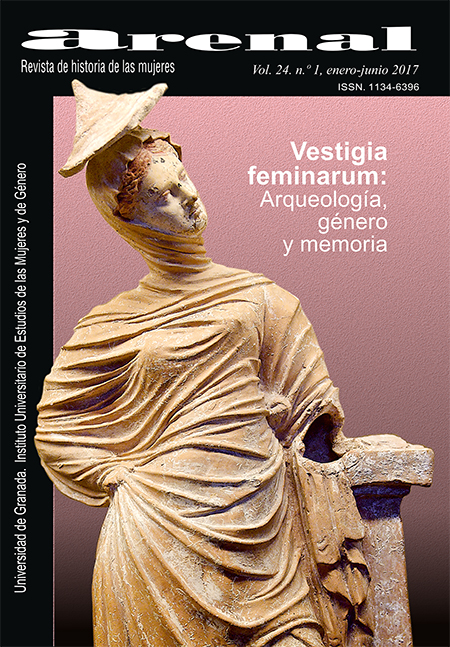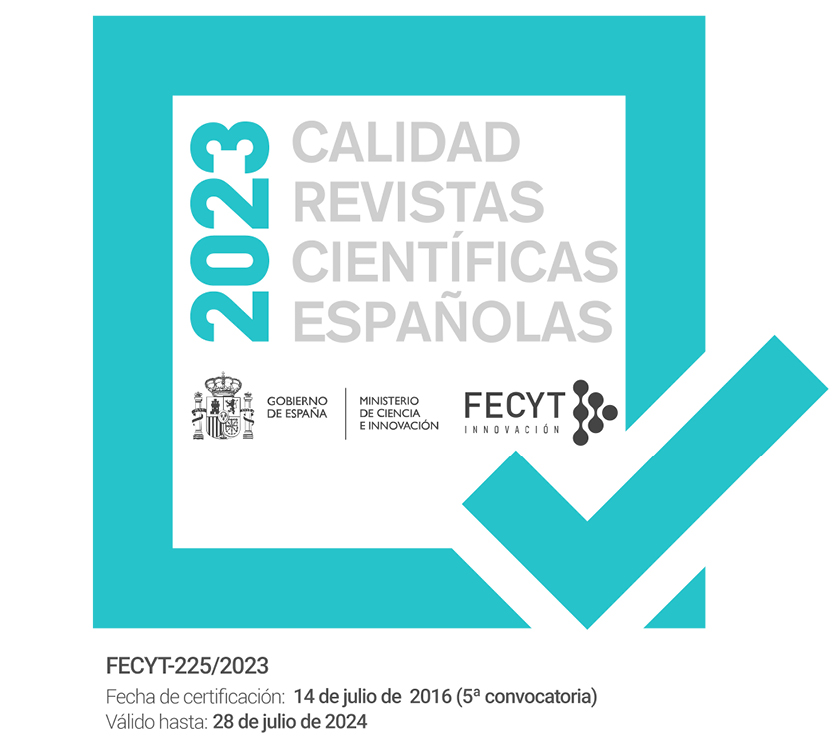Más allá de los estereotipos: nuevas tendencias en el estudio del género en arqueología clásica
DOI:
https://doi.org/10.30827/arenal.v24i1.5540Palavras-chave:
Arqueología clásica, Género, Mujeres, Estereotipos, Imágenes y representaciones, Espacios domésticosResumo
El presente trabajo parte de la premisa de que las diferencias de género fueron factores esenciales en las sociedades grecorromanas en términos de la socialización de niños y niñas, la estructuración de las actividades individuales, así como en la construcción de las culturas materiales. En ese último aspecto, en los últimos años la arqueología clásica ha ampliado los campos de investigación, proponiendo nuevas posibilidades con el estudio ampliado y redefinido de los espacios domésticos y también de las imágenes funerarias y otras formas de representación social. Gradualmente se ha abierto la posibilidad de contemplar el espacio de las ciudades antiguas poblado por una diversidad de grupos de edad, clases sociales y géneros, que convivían a diferentes escalas espaciales, desde la unidad familiar a la comunidad.
Downloads
Referências
ANGEL, J. Lawrence (1972): “Ecology and population in the eastern Mediterranean”. World Archaeology, 4-1: 88-105.
AULT, Bradley A. (2005): The Houses: The Organization and Use of Domestic Space. The excavations at Ancient Halieis. Vol. 2. Bloomington, Indiana University Press.
BERGER, John (1973): Ways of seeing. Londres, BBC y Penguin Books.
BERMEJO, Jesús (2014): Arqueolog’a de los espacios domŽsticos romanos: condiciones de vida y sociedad en la Meseta nordeste durante el per’odo imperial. (Temas Sorianos, 59). Soria, Diputación Provincial de Soria.
BERMEJO, Jesús (2014-2015): “In parva res oblitae: economías domésticas en los asentamientos rurales de la Hispania romana”. Anales de Arqueolog’a Cordobesa, 25-26: 145-168.
BISEL, Sara C. (1984): “The Dead Do Tell Tales”. National Geographic, 165.
BOOKIDIS, Nancy (1999): “Dining in the Sanctuary of Demeter and Kore at Corinth”. Hesperia, 68: 1-54.
BROWN, Shelby (1997): “ ‘Ways of seeing’ women in antiquity: an introduction to feminism in classical archaeology and ancient history”. En KOLOSKI-OSTROW, Ann Olga y LYONS, Claire L. (eds.): Naked Truths: Women, sexuality and gender in classical art and archaeology. Londres y Nueva York, Routledge, pp. 12-42.
CAHILL, Nicholas D. (2002): Household and City Organization at Olynthus. New Haven, CT: Yale University Press.
CONKEY, Margaret W. y WILLIAMS, Sarah (1991): “Original narratives: the political economy of gender in archaeology”. En DI LEONARDO, Micaela (ed.): Gender at the Crossroads of Knowledge. Berkeley, University of California Press, pp. 102-139.
CONNELLY, Joan (2007): Portrait of a Priestess. Princeton, Princeton University Press.
DETIENNE, Marcel (1979): “Violentes EugŽnies”. En DETIENNE, Marcel y VERNANT, Jean-Pierre (eds.): La Cuisine du sacrifice en pays grec. Par’s, Gallimard, pp. 183-214.
EATON, A. W. (2012): “What’s Wrong with the (Female) Nude? A Feminist Perspective on Art and Pornography”. En MAES, Hans y LEVISON, Jerrold (eds.): Art and Pornography: Philosophical Essays. Oxford, Oxford University Press, Scholarship Online.
FISHER, Marina (2011): “Hetaira’s Kalathos: Prostitutes and the Textile Industry in Ancient Greece”. Ancient History Bulletin, 25: 9-28.
FLOHR, Miko (2012): “Working and Living Under One Roof: Workshops in Pompeian Atrium Houses”. En ANGUISSOLA, Anna (ed.): Privata Luxuria: Towards an Archaeology of Intimacy. Munich: Herbert Utz Verlag, pp. 51-72.
KAMPEN, Natalie Boymel (1982): “Social Status and Gender in Roman Art: The Case of the Saleswoman”. En GARRARD, Mary D. y BROUDE, Norma (eds.): Feminism and Art History. Nueva York, Harper & Row, pp. 60-77.
KNAPP, A. Bernard (1998): “Who’s come a long way, baby?. Masculinist approaches to a gendered archaeology”. Archaeological Dialogues, 5: 91-125.
KNIGGE, Ursula B. (2005): Der Bau Z. Keremaikos, 17. Munich, Hirmer.
NEILS, Jenifer (2001): The Parthenon Frieze. Cambridge, Cambridge University Press.
MORRIS, Ian (2004): “Classical Archaeology”. En BINTLIFF, John (ed.): A Companion to Archaeology. Oxford, Blackwell, pp. 253-271.
NEVETT, Lisa (2011): “Towards a Female Topography of the Ancient Greek City: Case Studies from Late Archaic and Early Classical Athens (c.520-400 BCE). Gender & History, 23-3: 576-596.
LAZER, Estelle (2009): Resurrecting Pompeii. Londres, Routledge.
LISTON, Maria A. y PAPADOPOULOS, John K. (2004): “The ‘rich athenian lady’ was pregnant: The anthropology of a geometric tomb reconsidered”. Hesperia, 73-1: 7-38.
MA„AS, Irene y BERMEJO, Jesœs (2013): “El debate en torno al crecimiento econ—mico en el mundo romano: una propuesta anal’tica a partir de la arqueolog’a de las unidades domesticas”. Geri—n, 31: 269-286.
MULVEY, Laura (1975): “Visual pleasure and narrative cinema”. Screen. Oxford Journals, 16-3: 6-18.
ORLANDINI, Pietro (1966): “Lo scavo de Thesmophorion di Bitalemi e il culto delle divinitˆ ctonie a Gela”. Kokalos, 12: 8-35.
PLATT, Verity (2016): “The Matter of Classical Art History”. Daedalus. What’s New About the Old? Reassessing the Ancient World, special issue: 69-78.
RENFREW, Colin (1981): “The Great Tradition Versus the Great Divide: Archaeology as Anthropology?”. American Journal of Archaeology, 84-3: 287-298.
SCHMITT-PANTEL, Pauline (2001): “Les femmes grecques et l’andron”. Clio. Femmes, Genre, Histoire, 14: 155-181.
SMITH, R.R.R. et al. (2006): Roman Portrait Statuary from Aphrodisias: Aphrodisias II. Mainz am Rhein, Philipp von Zabern Verlag.
SMITHSON, Evelyn Lord (1968 1968): “The tomb of a rich athenian lady, ca. 850 B.C.”. Hesperia, 37-1: 77-116.
STEEDMAN, Carolyn (1992): “La ThŽorie qui n’en est pas une, or, Why Clio Doesn’t Care”. History and Theory, 31-4: 33-50.
T…LLE-KASTENBEIN, Renate (1994): Das archaische Wasserleitungsnetz fŸr Athen und seine SpŠteren Bauphasen. Mainz, Zabern.
TR†MPER, Monika (2012): “Gender and Space, ‘Public’ and ‘Private’”. En JAMES, Sharon L. y DILLON, Sheila (eds.): A Companion to Women in the Ancient World. Oxford, Blackwell, pp. 288-303.
WALLACE-HADRILL, Andrew (1994): Houses and Society in Pompeii and Herculanum. Princeton, Princeton University Press.
WEEDMAN, Kathryn (2006): “Gender and Ethnoarchaeology”. En NELSON, Sarah M. (ed.): Handbook of Gender in Archaeology. Walnut Creek, CA, Altamira, pp. 247-294.
WILK, Richard R. y RATHJE, William L. (eds.) (1982): “Archaeology of the Household: Building a Prehistory of Domestic Life”. American Behavioral Scientist, 25: 617-640.
YEGÜL, Fikret (2010): Bathing in the Roman world. Cambridge, Cambridge University Press.
Downloads
Publicado
Como Citar
Edição
Secção
Licença
Los/as autores/as que publican en esta revista están de acuerdo con los siguientes términos:
Los autores/as conservarán sus derechos de autor y garantizarán a la revista el derecho de primera publicación de su obra, el cuál estará simultáneamente sujeto a la Licencia de reconocimiento de Creative Commons 4.0 BY-NC-ND que permite a terceros compartir la obra siempre que se indique su autor y su primera publicación esta revista.
Los autores/as podrán adoptar otros acuerdos de licencia no exclusiva de distribución de la versión de la obra publicada (p. ej.: depositarla en un archivo telemático institucional o publicarla en un volumen monográfico) siempre que se indique la publicación inicial en esta revista.
Se permite y recomienda a los autores/as difundir su obra a través de Internet (p. ej.: en archivos telemáticos institucionales o en su página web) antes y durante el proceso de envío, lo cual puede producir intercambios interesantes y aumentar las citas de la obra publicada. (Véase El efecto del acceso abierto).


















